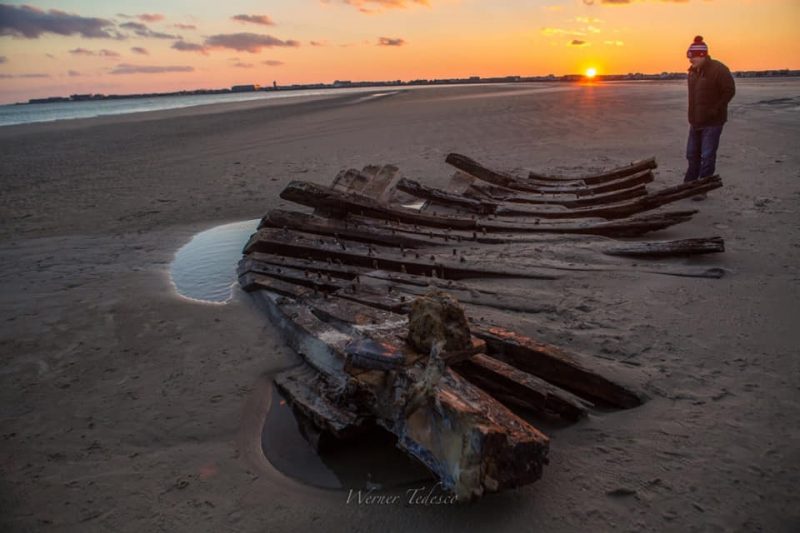In a photo from 2019, Sea Isle City Historical Society and Museum members Lynne Shirk, Ron Kovatis, Abby Powell, Arlene McFadden and Anne Organ stand next to what is believed to be a piece of a shipwreck on display at the Memorial Garden.
 By Donald Wittkowski
A weathered old piece of wood, grayish in color and close to 7 feet long, serves as one of the decorative centerpieces of the Memorial Garden outside the Sea Isle City Historical Society and Museum.
Believing it to be mere driftwood, a local family found the artifact on Sea Isle’s 64th Street beach in October 2017. The family, Tom and Jane O’Reilly and their son, Brian, donated the heavy piece of wood to the museum last summer when they were getting ready to move to a new house and didn’t want to lug it around.
“When he called me, he described it as a piece of driftwood,” Abby Powell, president of the Historical Society and Museum, recalled of her conversation with Tom O’Reilly. “I went over there and I saw wood pegs sticking out of it. It’s clearly from a shipwreck.”
Although they believed the wood came from a shipwreck, Powell and the museum’s volunteers had no idea which one. So it remained a mystery – until now.
Powell is confident the wood came from the remains of a shipwreck, believed to be from the 1800s, recently unearthed on a beach in Stone Harbor. Shifting sands revealed the oak timbers forming the ship’s ribs, which are about 25 feet long.
In December, Powell visited the shipwreck in Stone Harbor and was stunned by its similarity to the piece of wood in the museum’s Memorial Garden.
“I went there and said, ‘Oh, my gosh, this is totally a piece of the boat.’ There was no doubt in my mind,” she said.
By Donald Wittkowski
A weathered old piece of wood, grayish in color and close to 7 feet long, serves as one of the decorative centerpieces of the Memorial Garden outside the Sea Isle City Historical Society and Museum.
Believing it to be mere driftwood, a local family found the artifact on Sea Isle’s 64th Street beach in October 2017. The family, Tom and Jane O’Reilly and their son, Brian, donated the heavy piece of wood to the museum last summer when they were getting ready to move to a new house and didn’t want to lug it around.
“When he called me, he described it as a piece of driftwood,” Abby Powell, president of the Historical Society and Museum, recalled of her conversation with Tom O’Reilly. “I went over there and I saw wood pegs sticking out of it. It’s clearly from a shipwreck.”
Although they believed the wood came from a shipwreck, Powell and the museum’s volunteers had no idea which one. So it remained a mystery – until now.
Powell is confident the wood came from the remains of a shipwreck, believed to be from the 1800s, recently unearthed on a beach in Stone Harbor. Shifting sands revealed the oak timbers forming the ship’s ribs, which are about 25 feet long.
In December, Powell visited the shipwreck in Stone Harbor and was stunned by its similarity to the piece of wood in the museum’s Memorial Garden.
“I went there and said, ‘Oh, my gosh, this is totally a piece of the boat.’ There was no doubt in my mind,” she said.

 Wooden pegs and one iron or copper peg are visible protruding from the piece of wood at the museum.
The shipwreck's timber ribs are dotted with wooden pegs that were part of the vessel's construction. Similarly, the piece of wood at the Sea Isle City Historical Society and Museum has wooden pegs protruding from it, as well as what appears to be an iron or copper peg.
For Powell, the pegs were the evidence she needed to tie the museum’s piece of wood to the Stone Harbor shipwreck.
“I like the romanticism of being part of a shipwreck,” she said. “Even if it’s from a different shipwreck, it’s still part of Sea Isle’s history and we want to preserve it.”
The Historical Society is planning to have a bronze plaque made up to commemorate its shipwreck artifact and to honor the O’Reilly family, who donated it, Powell said. The plaque likely will be unveiled during a ceremony on Arbor Day in late April.
Wooden pegs and one iron or copper peg are visible protruding from the piece of wood at the museum.
The shipwreck's timber ribs are dotted with wooden pegs that were part of the vessel's construction. Similarly, the piece of wood at the Sea Isle City Historical Society and Museum has wooden pegs protruding from it, as well as what appears to be an iron or copper peg.
For Powell, the pegs were the evidence she needed to tie the museum’s piece of wood to the Stone Harbor shipwreck.
“I like the romanticism of being part of a shipwreck,” she said. “Even if it’s from a different shipwreck, it’s still part of Sea Isle’s history and we want to preserve it.”
The Historical Society is planning to have a bronze plaque made up to commemorate its shipwreck artifact and to honor the O’Reilly family, who donated it, Powell said. The plaque likely will be unveiled during a ceremony on Arbor Day in late April.